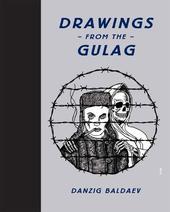
|
Drawings from the Gulag
Hardback
Main Details
| Title |
Drawings from the Gulag
|
| Authors and Contributors |
By (author) Danzig Baldaev
|
|
By (author) FUEL
|
|
By (author) Damon Murray
|
|
By (author) Stephen Sorrell
|
| Physical Properties |
| Format:Hardback | | Pages:240 | | Dimensions(mm): Height 200,Width 160 |
|
| Category/Genre | Graphic design |
|---|
| ISBN/Barcode |
9780956356246
|
| Classifications | Dewey:365.9470222 |
|---|
| Audience | |
|---|
| Illustrations |
Illustrated in black and white throughout
|
|
Publishing Details |
| Publisher |
FUEL Publishing
|
| Imprint |
FUEL Publishing
|
| Publication Date |
27 September 2010 |
| Publication Country |
United Kingdom
|
Description
Drawings from the Gulag consists of 130 drawings by Danzig Baldaev describing the history, horror and peculiarities of the Gulag system from its inception in 1918. Baldaev's father, a respected ethnographer, taught him techniques to record the tattoos of criminals in St Petersburg's notorious Kresty prison, where he worked as a guard. He was reported to the KGB who unexpectedly supported his work, allowing him the opportunity to travel across the former USSR.Witnessing scenes of everyday life in the Gulag, he chronicled this previously closed world from both sides of the wire. With every vignette, Baldaev brings the characters he depicts to vivid life: from the lowest zek (inmate) to the most violent tattooed vor (thief), all the practices and inhabitants of the Gulag system are depicted here in incredible, and often shocking, detail. In documenting the attitude of the authorities to those imprisoned, and the transformation of those citizens into survivors or victims of the Gulag system, this 'graphic novel' vividly depicts methods of torture and mass murder undertaken by the administration, as well as the atrocities committed by criminals on their fellow inmates.
ReviewsIn the Soviet Union, desk drawers became sarcophagi; entombed within them were the creative endeavours of the most talented and perceptive Soviet citizens. Yet it is best not to idealise such hiding spaces as reserves of dormant illumination; indeed, there may have been no limit to the depths of darkness possible within them. Consider the case of Danzig Baldaev. Born in 1925 in Ulan-Ude, in east-central Russia, Baldaev was the son of an ethnographer who was arrested as an enemy of the people. He grew up in an orphanage for the children of enemies and following his service in the second world war was forced, as he described it, by the NKVD (a forerunner of the KGB) to work as a warder at Kresty prison in Leningrad, now St Petersburg. His employment in the Soviet penal system took him all over the USSR, but in private, he poured the psychological detritus of his profession into a terrifying work of sadistic pornography, which he dedicated, in 1988, to Alexander Solzhenitsyn.--Roland Elliott Brown "The Observer"
|